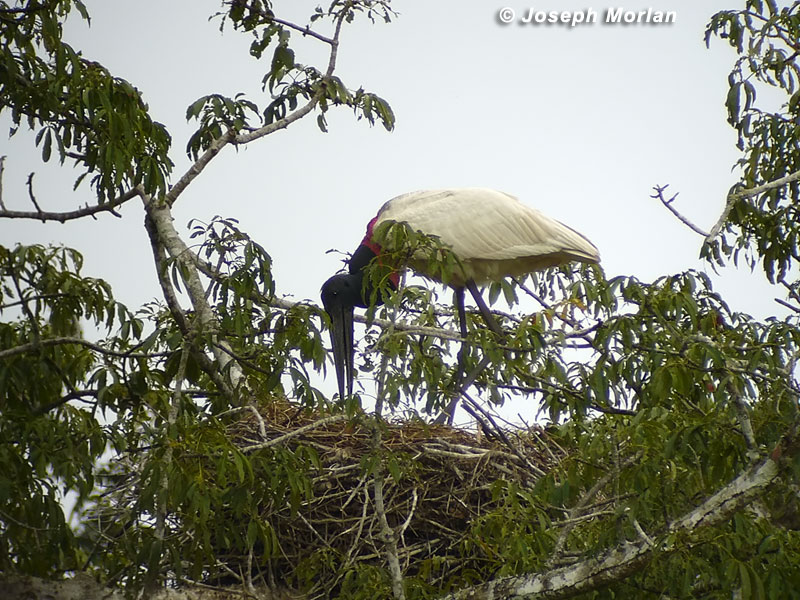



The Jabiru is said to be the largest flying bird in the Americas with a wing span of about 9 feet. However, the American White Pelican has a wing span almost as long and averages heavier. Several online claims that the Jabiru has a wing span of 12 feet need substantiation.
The name Jabiru (pronounced (JAB-eh-roo), comes from the Tupi-Guaraní language and means "swollen neck". The red collar is featherless and elastic often giving the bird an ungainly swollen necked appearance as in this photo. The massive bill is up to a foot in length and turned slightly upward.
The species ranges from Mexico into South America, but the highest concentrations in Central America are in Belize and adjacent areas. Extensive studies in Belize (see ref.) have found that most nests are located outside of protected areas making the species a conservation concern.
Nests, such as this one, are large twig structures on horizontal limbs of large trees. Pairs use the same nest in successive years, adding material and enlarging the nest annually. This nest has reportedly been in active use for several years. We observed egg-turning behavior and incubation. In another month, we would have probably seen more activity with young in the nest.
Males average slightly larger than females. Above, the male on the right is relieving the female on the left from incubation duties. Note the more swollen neck and brighter red skin on the male.
In Australia, the name Jabiru is sometimes applied to a totally different bird, the Black-necked Stork (Ephippiorhynchus asiaticus) of India, SE Asia and Australia. Some people we met in Belize were confused by this, thinking they had already seen Jabiru in Australia.
Some web sites, such as BirdForum specifically prohibit posting photos of nesting birds out of concern for the welfare of the subjects. That is understandable and I support them in that. But they cannot know in all cases the true circumstances of how the photos were obtained, and the extent of the disturbance if any. For them it is better to make a broad rule than to try to adjudicate the specifics of every individual case.
One of the significant advantages of digiscoping over conventional photography is that you can get reasonable photos from a much a greater distance. Thus there is much less chance that you will disturb the birds or change their behavior. In this case, the nest was at a considerable distance (I guess about 200 meters away), and visible from a public road, so I don't think our observations and photography had any impact or interfere with normal nesting behavior. If anybody feels that I shouldn't have taken this photo, or posted it here, please let me know your concerns privately.
Digiscoped with Panasonic DMC-LZ5 | Nikon FieldScope III | 30XWA | hand-held (no adapter)
Reference:
Barnhill, R. A. et al. 2005. Breeding biology of Jabirus (Jabiru mycteria) in Belize. Wilson Bulletin, 117(2):142-153.
(http://www.bioone.org/doi/full/10.1676/04-078)